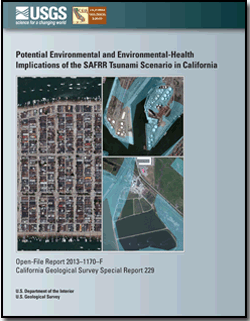 Abstract
Abstract
The California Tsunami Scenario models the impacts of a hypothetical, yet plausible, tsunami caused by an earthquake offshore from the Alaska Peninsula. In this chapter, we interpret plausible tsunami-related contamination, environmental impacts, potential for human exposures to contaminants and hazardous materials, and implications for remediation and recovery.
Inundation-related damages to major ports, boat yards, and many marinas could release complex debris, crude oil, various fuel types and other petroleum products, some liquid bulk cargo and dry bulk cargo, and diverse other pollutants into nearby coastal marine environments and onshore in the inundation zone. Tsunami-induced erosion of contaminated harbor bottom sediments could re-expose previously sequestered metal and organic pollutants (for example, organotin or DDT).
Inundation-related damage to many older buildings could produce debris containing lead paint, asbestos, pesticides, and other legacy contaminants. Intermingled household debris and externally derived debris and sediments would be left in flooded buildings. Post tsunami, mold would likely develop in inundated houses, buildings, and debris piles. Tsunamigenic fires in spilled oil, debris, cargo, vehicles, vegetation, and residential, commercial, or industrial buildings and their contents would produce potentially toxic gases and smoke, airborne ash, and residual ash/debris containing caustic alkali solids, metal toxicants, asbestos, and various organic toxicants. Inundation of and damage to wastewater treatment plants in many coastal cities could release raw sewage containing fecal solids, pathogens, and waste chemicals, as well as chemicals used to treat wastewaters.
Tsunami-related physical damages, debris, and contamination could have short- and longer-term impacts on the environment and the health of coastal marine and terrestrial ecosystems. Marine habitats in intertidal zones, marshes, sloughs, and lagoons could be damaged by erosion or sedimentation, and could receive an influx of debris, metal and organic contaminants, and sewage-related pathogens. Debris and re-exposed contaminated sediments would be a source of sea- or rain-water-leachable metal and organic contaminants that could pose chronic toxicity threats to ecosystems.
If human populations are successfully evacuated prior to the tsunami arrival, there would be no or limited numbers of drownings, other casualties, or related injuries, wounds, and infections. Immediately after the tsunami, human populations away from the inundation zone could be transiently exposed to airborne gases, smoke, and ash from tsunamigenic fires. Cleanup and disposal, particularly of hazardous materials, would pose substantial logistical challenges and economic costs. Given the high value of the coastal residential and commercial properties in the inundation zone, it can be postulated that there would be substantial insurance claims for environmental restoration, mold mitigation, disposal of debris that contains hazardous materials, and costs of litigation related to environmental liability.
Post-tsunami cleanup, if done with appropriate mitigation (for example, dust control), personal protection, and disposal measures, would help reduce the potential for cleanup-worker and resident exposures to toxicants and pathogens in harbor waters, debris, soils, ponded waters, and buildings. A number of other steps can be taken by governments, businesses, and residents to help reduce the environmental impacts of tsunamis and to recover more quickly from these environmental impacts. For example, development of State and local policies that foster rapid assessment of potential contamination, as well as rapid decision making for disposal options should hazardous debris or sediment be identified, would help enhance recovery by speeding cleanup.